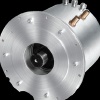|
Battery Electric Vehicles
1. Introduction
To reduce greenhouse gas emissions and improve security of energy supply the European
Union aimed at a substitution of 10% of the conventional fuels (conventional diesel and
gasoline) in the road transport sector before the year 2020 (VROM, 2007).
Also a reduction of 20% greenhouse gasses in 2020 compared to the levels of 1990 was
proposed by the European Union in 2007.
The transport sector accounts for about 31% of European energy use (EEA, 2008) and 25% of
the European CO2 emissions. A large part of the CO2 emission reduction can be achieved by
introducing alternative fuels and drive trains, like hydrogen, fuel cell technology and electric
powered vehicles. These alternatives also can help reduce the dependence on oil from
unstable regions in the Middle-East.
The problems alternative drive trains and fuels are facing right now are the high costs and the
lack of a good infrastructure for alternative fuels. Also in the case of battery powered vehicles
a problem is the range of the car. The current batteries are not capable yet to power a light
duty vehicle for more than two or three hundred kilometers (Van Mierlo, 2006). However the
future of battery powered vehicles can be bright. The battery technology has improved
significantly the last decades mainly through the development of mobile phones and laptops.
Lithium-ion batteries are the standard batteries in mobile phones and laptops right now. Those
batteries are also being used in the new battery electric vehicles coming on the market the
next few years and are likely to be the standard for electric vehicles the next decade (Kennedy
et al. 2000).
The main problems electric vehicles are facing are the batteries, costs and charging facilities.
Because of the limit in range of BEVs the cars that going to be introduced into the market
most likely will be small city cars. Nissan, Mitsubishi and Smart are examples of car
manufacturers who are going to introduce the electric city car the coming years.
In this research a chain analysis is performed for battery powered city vehicles on costs,
efficiency, fuel economy and emissions. Those results will be compared with conventional
internal combustion engine vehicles powered by fossil fuels.
The research also focuses on the development of the battery technology. As the battery is a
crucial part in the electric vehicle the success of the car is mainly dependent on the battery
development. This research tries to map whether the battery can meet the required targets for
the usage in electric vehicles considering costs, lifetime, specific energy and specific power.
1.1 Problem definition
This research focuses on the W-T-W efficiency, primary energy consumption, lifecycle cost
and CO2 emissions involved with driving a BEV in the Netherlands. Only light duty vehicles
are being researched as they are most likely to be the main BEV introduced into the market.
The BEV seems to be a relatively clean and efficient way of using energy in comparison with
other fuels (Mierlo et al. 2006). Therefore there is a great potential of saving energy and
reduce emissions when the BEV is being introduced on a large scale.
read more
|
|
Какъв автомобил бихте закупили?

|
Декември 2025
|

|
|
| Нед |
Пон |
Вто |
Сря |
Чет |
Пет |
Съб |
| | | | | | | | | | | | | | | | | | | | | | | | | | | | | | | | | | | |
|














